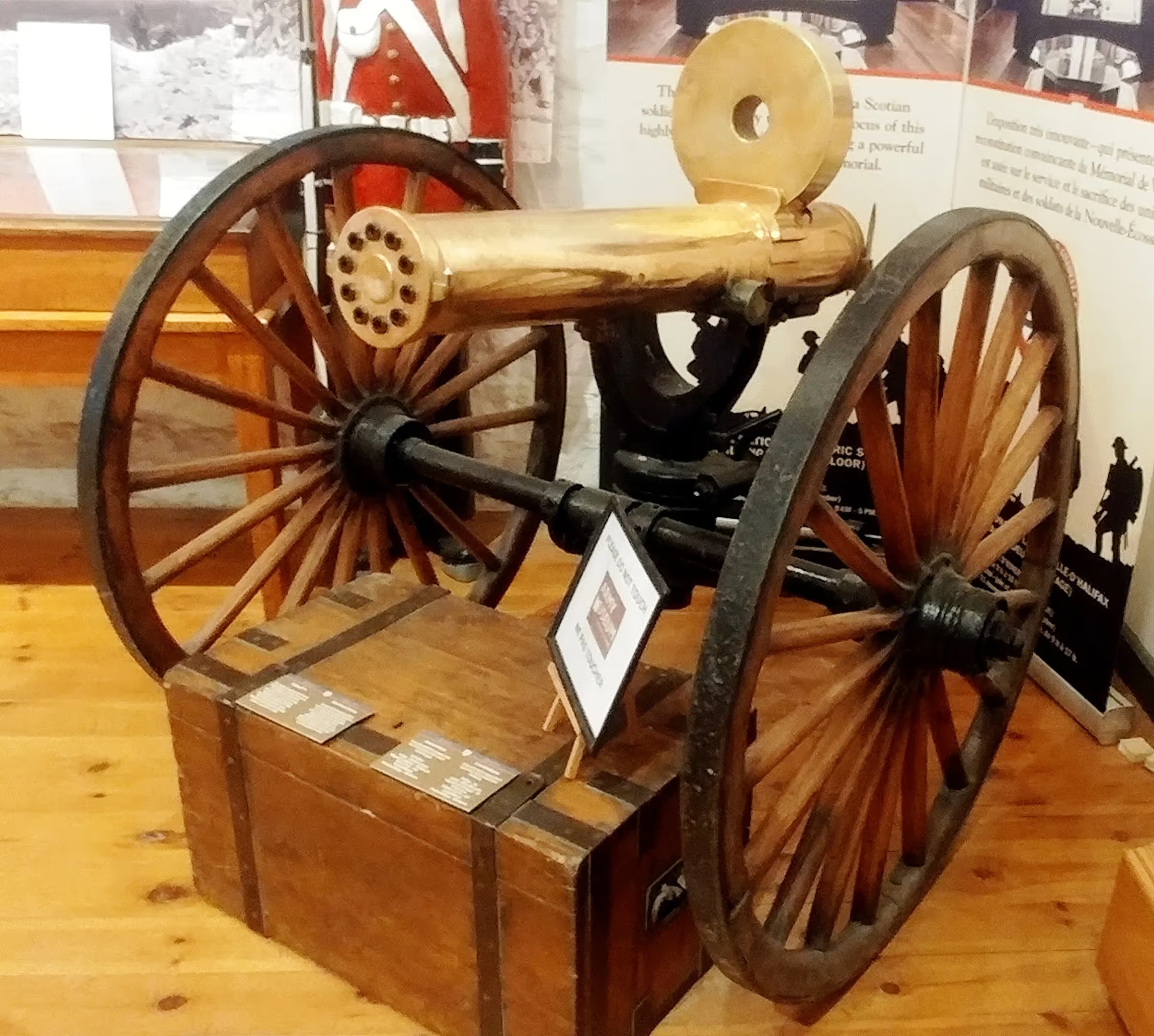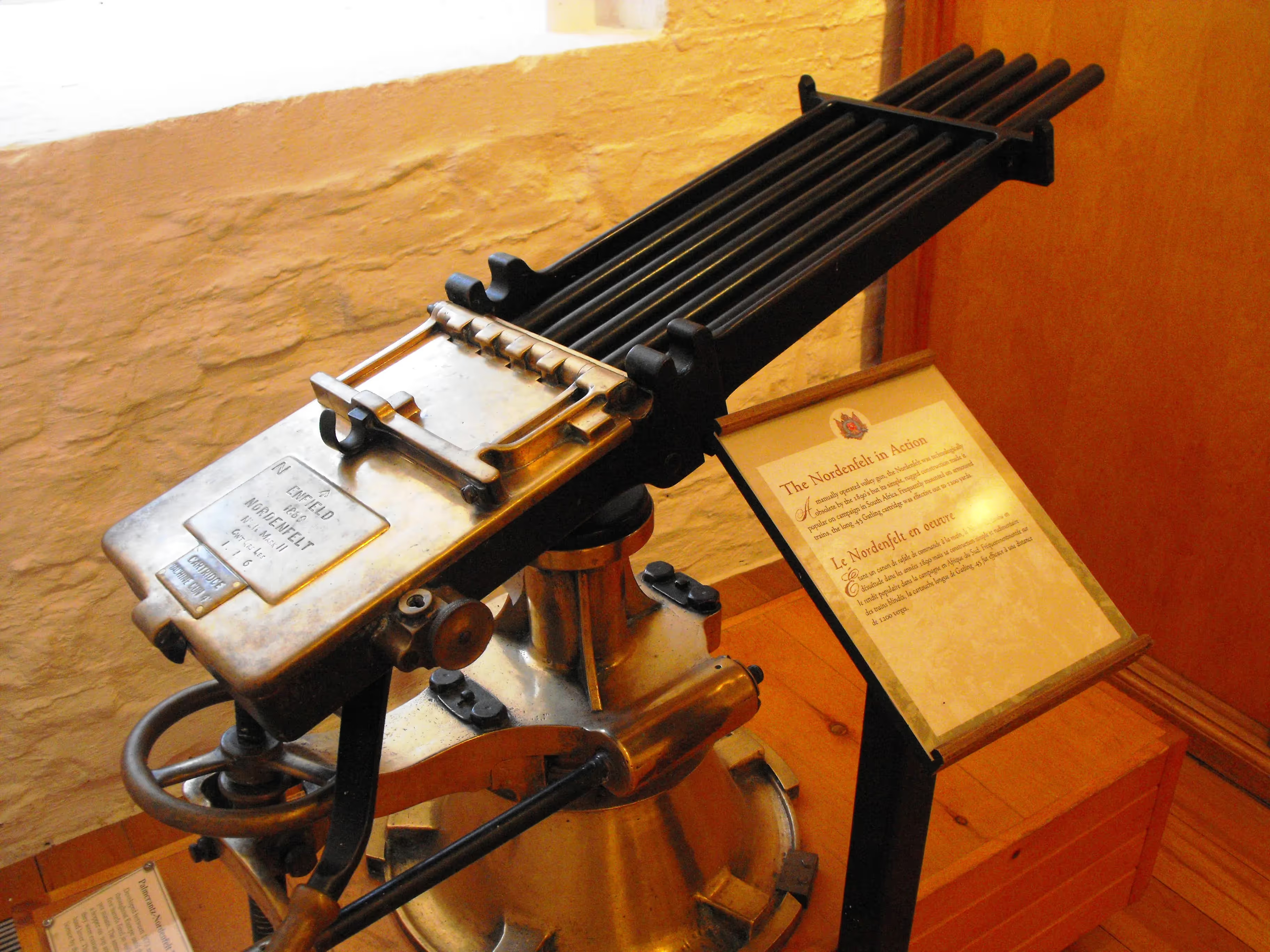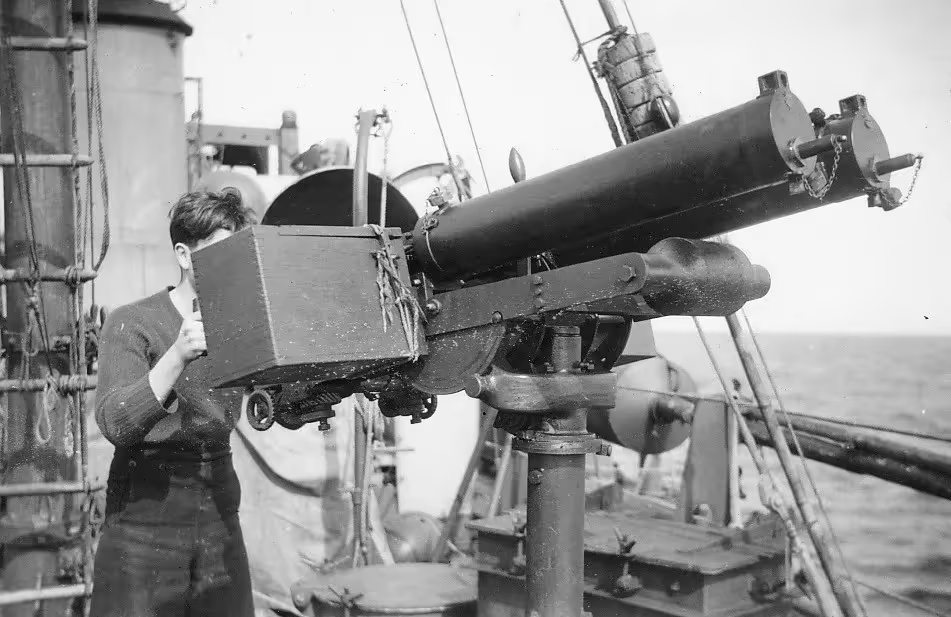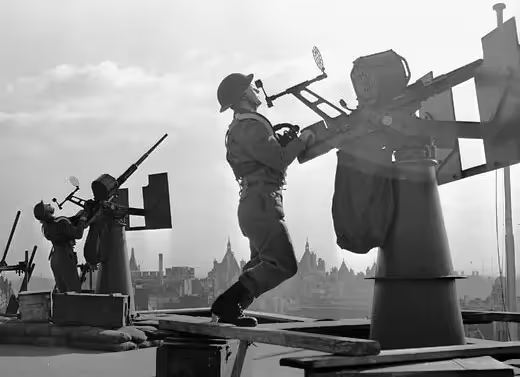Artillery in Canada (9) Nova Scotia: Halifax, The Army Museum, Halifax Citadel National Historic Site
Artillery in Halifax, The Army Museum
The Army Museum, Halifax Citadel National Historic Site, Cavalier Building (second floor), Halifax, Nova Scotia

(Author Photo)
Cast Iron possible 3-pounder Smoothbore Muzzleloading Gun, heavily corroded, trunnions broken, recovered from the sea near Louisbourg.










(Author Photos)
.45-calibre Gatling Battery Gun, Colt Fire Arms, (Serial No. 00).

(Library and Archives Canada Photo, MIKAN No. 3228076)
45-inch 5-barrel Nordenfelt Mk. II Machine Gun mounted on a galloping carriage, 1887.

(Royal Navy Photo)
45-inch 5-barrel Nordenfelt Mk. II Machine Gun, and Royal Navy Marine gunners, 1890s.



(Gary Melville, Photos)




(Author Photos)
5-inch 5-barrel Nordenfelt Mk. II Machine Gun, stamped Enfield 1889, Nordenfelt No. 216 Mark II, weight 1-1-6 (146 lbs), Cartridge Machine Gun 41.

(Guilmann Photo)
Ammunition feed system for the 5-inch 5-barrel Nordenfelt Mk. II Machine Gun.
The Nordenfelt gun was a is a multiple barrel organ gun that had a row of up to twelve barrels (he one shown here in the Army Museum has five). It was fired by pulling a lever back and forth and ammunition was gravity fed through chutes for each barrel. It was produced in a number of different calibres from rifle up to 25 mm (1 inch). Larger calibres were also used, but for these calibres the design simply permitted rapid manual loading rather than true automatic fire. This specific Nordenfelt Gun was intended for use as an anti-personnel weapon.

(PO2 Tim Muise Photo)
Vickers .303-inch Machine Gun, mounted on the wall inside the entrance to HMCS Scotian. This MG has been moved to the Army Museum in the Halifax Citadel.



(Author Photos)
Vickers .303-inch Machine Gun.





(Author Photos)
German First World War 7.92-mm Maxim Spandau MG 08 Machinegun, possibly (Serial Nr. 1712), mounted on a Schlitten stand. This MG 08 was captured on 27 Sep 1918 by the 78th Battalion (Winnipeg Grenadiers), of the 12th Brigade within the 4th Canadian Division of the Canadian Expeditionary Force (CEF) in France.



(Author Photos)
German First World War 7.58-cm leichtes Minenwerfer neuer Art (7.58-cm leMW), (Serial Nr. 18351), 213. This trench mortar was captured on 26 Aug 1918 by the 19th Battalion, 4th Infantry Brigade, 2nd Canadian Division, Canadian Expeditionary Force (CEF), at Guemappe, France.
The 7.58 cm Minenwerfer a.A. (alter Art or old model) (7.58 cm leMW). The Germans fielded a whole series of mortars before the beginning of the First World War. Their term for them was Minenwerfer, literally mine-thrower; they were initially assigned to engineer units in their siege warfare role. By the Winter of 1916-17, they were transferred to infantry units where the leMW's light weight permitted them to accompany the foot-soldiers in the advance. In common with Rheinmetall's other Minenwerfer designs, the leMW was a rifled muzzle-loader that had hydraulic cylinders on each side of the tube to absorb the recoil forces and spring recuperators to return the tube to the firing position. It had a rectangular firing platform with limited traverse and elevation. Wheels could be added to ease transportation or it could be carried by at least six men. In 1916, a new version, designated as the n.A. or neuer Art, was fielded that included a circular firing platform, giving a turntable effect, which permitted a full 360 degree traverse. It also had a longer 16 inches (410 mm) barrel and could be used for direct fire between 0° and 27° elevation if the new 90 kg (200 lb) trail was fitted to absorb the recoil forces. In this mode it was pressed into service as an anti-tank gun.
.avif)
(Author Photo)
.303-inch Vickers MG.

(Library and Archives Canada Photo, MIKAN No. 3356796)
Twin .50 cal MGs, shipboard.


(Author Photos)
Twin .50-calibre AA Heavy Machine Guns.

(Catherine Crewe Photo)
HMCS Quinte (J166) (Bangor-class), twin Browning.50-calibre water-cooled AA machine guns.

(Library and Archives Canada Photo, MIKAN No. 3584934)
.50-cal twin-mount AA Gun, 6 May 1954.

3
(Library and Archives Canada Photo, MIKAN No. 3238905)
Oerlikon 20-mm/70 Light Anti-Aircraft Guns being manned on the roof of the Canadian Military Headquarters (CMHQ), London, UK, ca 1942.

(Author Photo)
Oerlikon 20-mm/70 Light Anti-Aircraft Gun.

(Author Photos)
German 81-mm Mortar, (Serial Nr. FG214).

(Author Photos)
75-mm M20 RR Recoilless Rifle, (Serial No. 7229225).

(Author Photo)
Pistol like device used as an electrical initiator for firing large coastal guns. 1915 Model.
.avif)
(Author Photo)
1915 Ford Field Ambulance in the Citadel Courtyard.





